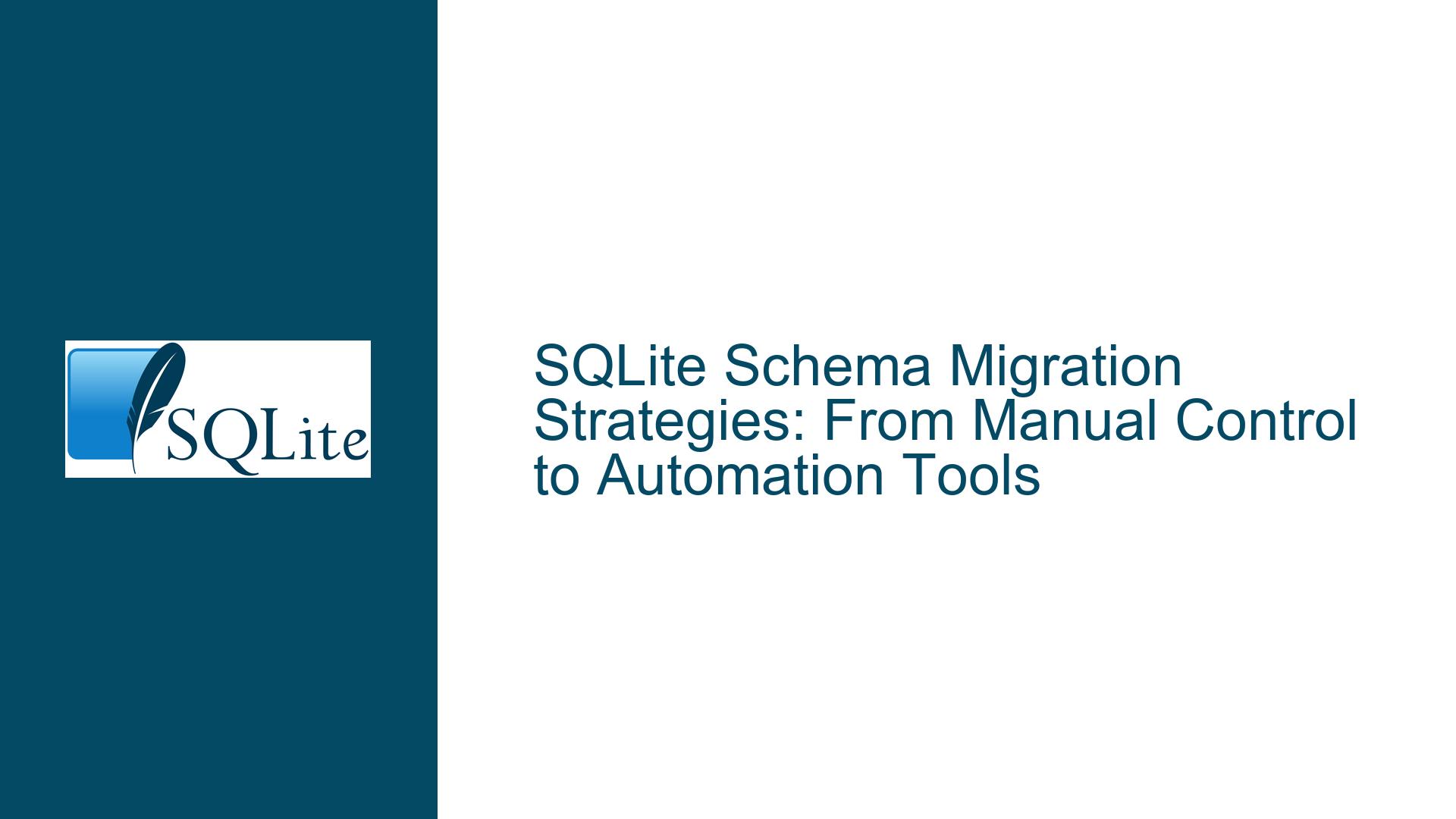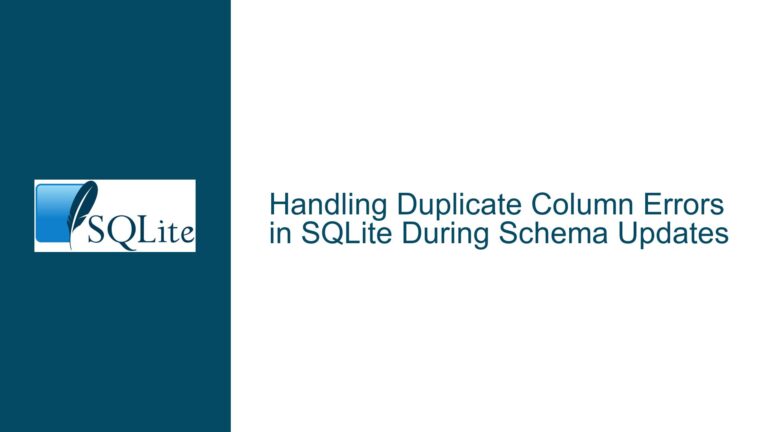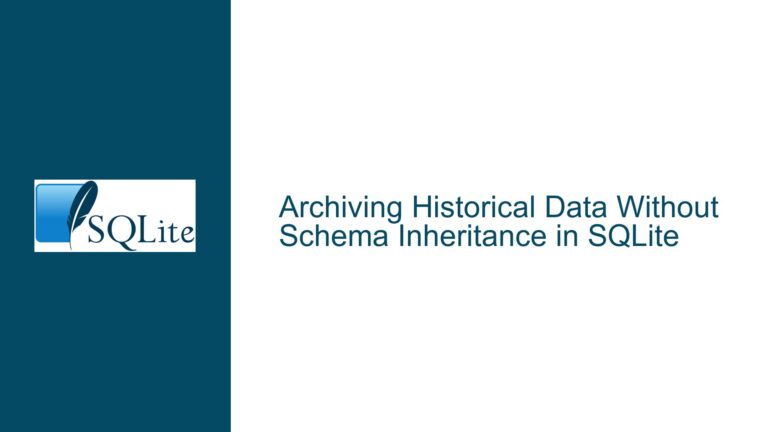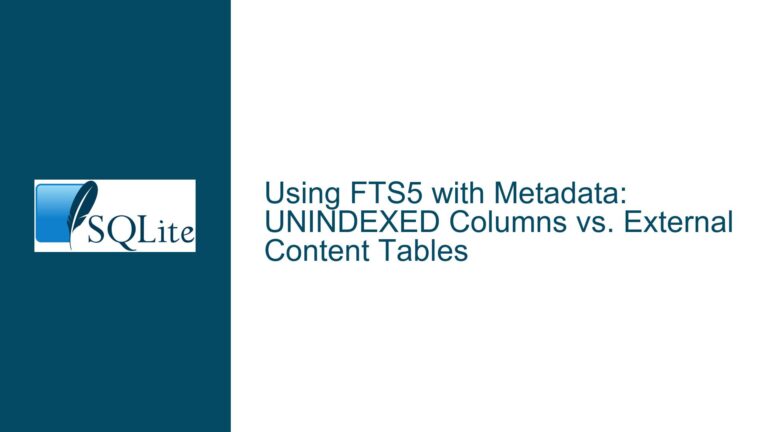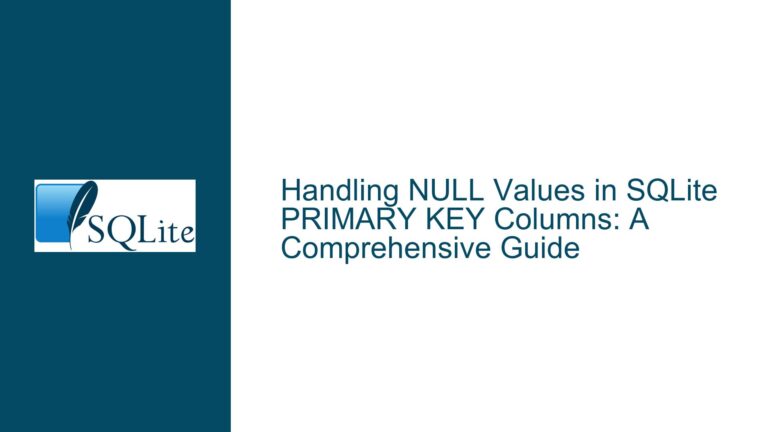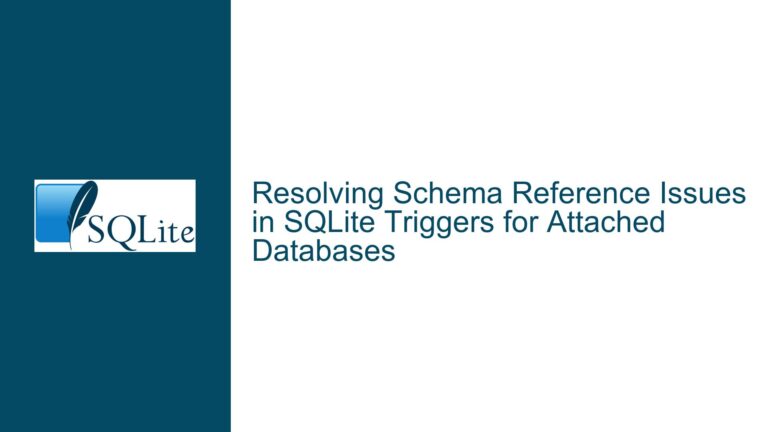SQLite Schema Migration Strategies: From Manual Control to Automation Tools
Understanding SQLite Database Evolution in Multi-Developer Environments
SQLite schema migration presents unique challenges and opportunities distinct from traditional client-server databases. The discussion reveals a fundamental split between two primary approaches to managing schema evolution: integrated application-level control and external migration tools.
The core challenge stems from SQLite’s embedded nature and file-based architecture, where schema changes must be coordinated across multiple development environments and deployment scenarios. SQLite’s serverless architecture means each application instance directly manages its database file, making version control and schema synchronization critical for maintaining data integrity.
Several key patterns emerge from developer experiences. The traditional approach leverages SQLite’s built-in pragmas, specifically application_id and user_version, to track and manage schema versions. This method involves embedding migration logic directly within the application code, where version checks trigger sequential schema updates through SQL statements executed in ordered transactions.
A more sophisticated approach involves declarative schema management, where the desired database structure is defined in a single source of truth. This method compares the current database state against the desired schema by analyzing the sqlite_schema table, automatically generating the necessary migration statements. This approach offers better maintainability and reduces the risk of migration errors.
External tools like yoyo-migrations and Sqitch provide alternative solutions, offering CLI-based workflows familiar to developers coming from traditional database backgrounds. These tools bring additional features such as rollback capabilities and migration history tracking, though some developers argue these features add unnecessary complexity to SQLite’s inherently simple architecture.
The choice between integrated and tool-based approaches often depends on specific project requirements. Applications managing multiple SQLite databases simultaneously, particularly in scenarios where each user has a dedicated database file, tend to favor integrated migration approaches for their simplicity and direct control. Conversely, larger teams working on complex schemas often benefit from the structure and additional features provided by dedicated migration tools.
Performance considerations play a crucial role in migration strategy selection. SQLite’s transaction model requires careful attention to ensure schema updates occur atomically, particularly when handling multiple databases or concurrent access patterns. The discussion emphasizes the importance of maintaining transaction boundaries during migrations to prevent data corruption or inconsistent states.
The evolution of SQLite schema management reflects a broader trend in database development practices, where the balance between simplicity and feature richness continues to shape tool selection and implementation strategies. The forum discussion highlights how different approaches can coexist, each serving specific use cases while maintaining SQLite’s core principles of reliability and simplicity.
Root Causes Behind SQLite Schema Migration Complexities
Schema migration challenges in SQLite environments typically originate from several interconnected factors, with each cause potentially amplifying related issues. Transaction management stands as a primary concern, where improper handling of migration transactions can lead to database corruption or inconsistent states. The atomic nature of SQLite operations requires careful orchestration of schema changes, particularly when multiple tables or indices are involved in a single migration.
Version tracking mechanisms present another significant challenge area. SQLite’s built-in version tracking through user_version pragma requires careful implementation to handle both forward and backward compatibility. Database administrators must consider scenarios where newer application versions attempt to access older database schemas, or vice versa, potentially leading to application failures or data access issues.
Concurrent access patterns create additional complexity layers in migration scenarios. While SQLite supports multiple readers, its single-writer limitation means migration processes must carefully manage timing and access patterns. Applications serving multiple users or processes must implement robust locking strategies to prevent migration conflicts while maintaining service availability.
File system interactions introduce another dimension of potential issues. SQLite’s file-based nature means migrations must account for file system permissions, space constraints, and backup procedures. Failed migrations due to insufficient disk space or permission issues can leave databases in intermediate states, requiring careful recovery procedures.
Schema dependency management represents a subtle but critical challenge. Tables with foreign key relationships, views depending on specific column structures, and triggers tied to particular schema versions create complex dependency chains. Migrations must carefully sequence changes to maintain these relationships while avoiding circular dependencies.
| Migration Component | Associated Risks | Impact Severity |
|---|---|---|
| Transaction Boundaries | Data corruption, Partial updates | Critical |
| Version Control | Schema incompatibility, Application crashes | High |
| Concurrent Access | Deadlocks, Migration failures | Moderate |
| File System Operations | Incomplete migrations, Database corruption | Critical |
| Schema Dependencies | Broken relationships, Cascade failures | High |
Environment synchronization poses challenges in development workflows. Different development environments may contain varying data volumes and structures, leading to migration behaviors that differ between development, testing, and production environments. These discrepancies can mask potential migration issues until they surface in production deployments.
Performance degradation risks emerge during migration operations. Large-scale schema changes, particularly those involving table restructuring or index rebuilding, can temporarily impact database performance. Applications must account for these performance windows and implement appropriate mitigation strategies.
Error recovery capabilities present significant technical hurdles. Failed migrations require robust rollback mechanisms, but SQLite’s transactional nature means certain schema changes cannot be easily reversed without careful planning. This limitation necessitates comprehensive backup strategies and well-tested recovery procedures.
Resource utilization during migrations requires careful consideration. Memory consumption during large table alterations, temporary space requirements for index rebuilding, and CPU utilization during data transformations can impact system stability. Applications must balance migration performance against resource constraints while maintaining system responsiveness.
Data integrity verification poses ongoing challenges throughout migration processes. Schema changes affecting data types or constraints require validation mechanisms to ensure data consistency. Applications must implement appropriate validation strategies while managing the performance impact of verification procedures.
These interconnected causes create a complex web of considerations for SQLite schema migration implementation. Understanding these root causes enables developers to implement more robust migration strategies and anticipate potential issues before they impact production systems.
Implementing Robust SQLite Schema Migration Solutions
Schema migration implementation requires a systematic approach combining preventive measures, monitoring systems, and recovery procedures. The following comprehensive strategy addresses common migration challenges while maintaining database integrity and application stability.
Transaction Management Implementation
A robust transaction management system forms the foundation of reliable schema migrations. Each migration should execute within a single transaction scope, utilizing SQLite’s WAL mode for improved concurrency. Transaction boundaries must encompass all schema modifications, including auxiliary operations such as index rebuilding and constraint updates. Implementation should include explicit BEGIN and COMMIT statements, with ROLLBACK handlers for error conditions.
| Transaction Phase | Key Operations | Validation Points |
|---|---|---|
| Pre-Migration | Schema backup, Version check | Current schema integrity |
| Migration Execution | Schema modifications, Data transforms | Transaction boundaries |
| Post-Migration | Index rebuilding, Constraint validation | Data consistency |
Version Control Integration
Version tracking implementation requires both database-level and application-level components. The user_version pragma serves as the primary version indicator, complemented by a dedicated version tracking table containing detailed migration history. Schema version checks should execute during application startup, triggering appropriate migration paths based on version differentials.
| Version Component | Implementation Detail | Purpose |
|---|---|---|
| Version Table | Migration timestamp, Author, Description | Audit trail |
| Version Pragma | Integer version number | Quick checks |
| Version Functions | Comparison logic, Migration triggers | Flow control |
Concurrent Access Management
Implementing proper concurrent access patterns requires careful coordination between migration processes and regular application operations. A connection pooling system should manage database access, with migration operations receiving priority access through connection queue management. Implementation should include timeout handlers and retry logic for concurrent access scenarios.
Backup and Recovery Systems
A comprehensive backup strategy must precede any migration attempt. Implementation should include automated backup procedures, utilizing SQLite’s online backup API for consistent snapshots. Recovery procedures should support both full database restoration and partial recovery scenarios, with validation steps ensuring backup integrity before migration initiation.
| Backup Type | Timing | Retention |
|---|---|---|
| Full Backup | Pre-migration | 30 days |
| WAL Files | Continuous | 7 days |
| Schema Dumps | Weekly | 90 days |
Performance Optimization Techniques
Migration performance optimization requires careful attention to execution patterns. Large tables should utilize temporary indices during migration, with careful management of memory allocation through appropriate PRAGMA settings. Implementation should include progress monitoring and resource utilization tracking to prevent system overload.
Error Handling Framework
A robust error handling framework must capture and manage various failure scenarios. Implementation should include detailed logging of migration steps, error conditions, and recovery attempts. Error handlers should distinguish between recoverable and non-recoverable errors, implementing appropriate response strategies for each category.
| Error Category | Response Strategy | Recovery Action |
|---|---|---|
| Schema Conflicts | Automatic rollback | Version reversion |
| Resource Constraints | Staged execution | Resource allocation |
| Data Validation | Partial rollback | Incremental repair |
Monitoring and Validation Systems
Comprehensive monitoring systems should track migration progress and database health metrics. Implementation should include performance counters, schema validation checks, and data integrity verification. Monitoring systems should provide real-time visibility into migration status and early warning of potential issues.
Development Workflow Integration
Integration with development workflows requires standardized migration procedures across all environments. Implementation should include automated testing of migration scripts, with particular attention to data volume variations between environments. Development tools should support migration script generation and validation.
| Environment | Migration Validation | Data Sampling |
|---|---|---|
| Development | Full script testing | Synthetic data |
| Staging | Volume testing | Production subset |
| Production | Dry run validation | Full dataset |
Documentation and Maintenance
Maintaining comprehensive migration documentation ensures long-term maintainability. Implementation should include detailed schema change logs, dependency mappings, and performance impact assessments. Documentation should cover both technical details and operational procedures for various migration scenarios.
These implementation strategies provide a framework for reliable SQLite schema migrations. Success requires careful attention to detail, comprehensive testing, and robust error handling mechanisms. Regular review and updates of migration procedures ensure continued effectiveness as application requirements evolve.
